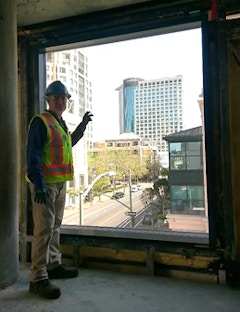
19 results
-
 The historical focus on reducing the carbon footprint of a building has recently shifted to include more emphasis on embodied carbon, the carbon…
The historical focus on reducing the carbon footprint of a building has recently shifted to include more emphasis on embodied carbon, the carbon… -

FreMarq Innovations Inc
- Organization
FreMarq engineers and fabricates high performing thermal fenestration products, curtain wall, fixed windows, window walls, vents and sunshades. Our primary focus is to reduce the energy consumption and carbon footprint of commercial buildings by improving the thermal efficiency of its envelope.
-

Addressing climate change through façade design - Vaclav Hasik
- Article by Vaclav Hasik
There is a growing awareness and interest in understanding the carbon footprint of material manufacturing, opening doors to new opportunities in facade design and manufacturing innovation. There are steps and decisions we can make today to help fight climate change.
-

Sustainable Silicone
- Paper by Jon Kimberlain · Adrienne Bowman-Grittini · Stanley Yee
Silicone materials have a long history in high performance building projects. Known for durability, they can reduce a building’s carbon footprint by
-

Highly Efficient Façades with Innovative Shading and Light Control
- Paper by Klaus Reuschle, Project Director Robert Matthew Noblett, Partner Michelle Siu-Ching Lee, Roman Schieber, Associate Director ppa.
The Science and Engineering Complex (SEC) on the Allston Campus is the largest new building at Harvard University in recent decades with a footprint… -

Embodied Carbon
- Article by Helen Sanders
Welcome to this edition of the SKINS newsletter, which is all about carbon! As guest editor this month, I am representing FTI’s embodied carbon (EC) working group. This issue highlights several important topics relative to embodied and the trade-offs with operational carbon.
-

Exploring Heritage: Building on the Past
- Article by Mic Patterson
Welcome to this edition of the SKINS newsletter, which is all about carbon! As guest editor this month, I am representing FTI’s embodied carbon (EC) working group. This issue highlights several important topics relative to embodied and the trade-offs with operational carbon.
-

Xilinx Case Study
- Paper by Michael Martinez, LEED AP, Stet Sanborn, AIA, LEED AP, CPHC,
The transformation of a dark and inhumane 1970s tilt-up concrete office building into a high performance, light-filled modern workplace was enabled… -

Curb Your Carbon, Knave!
- Article by Mic Patterson, PhD LEED AP+
A question for architects and building industry: Can our cities be part of the solution to the challenges facing humanity, or are they intrinsically and inevitably a big part of the problem? To move beyond the latter demands nothing less than a fundamental shift in the way we think about buildings.
-

Stop F*cking Around – Build Our Zero Carbon Economy Now
- Article by Drew Shula
To avoid the worst effects of the climate crisis, we urgently need to reduce carbon emissions now. But that's not enough! This original article for SKINS by Drew Shula is a veritable manifesto on the why and how of climate action for all of us.
-

Net Zero 2023 Conference
- Event by Verdical Group
Don't just wait for the future, build it. NZ23, the world's largest net zero conference, is building a #NetZeroFuture for all. Learn more & register at www.NetZeroConference.com
-

BESTfest
- Event by National Institute of Building Sciences
Since the beginning of the pandemic, building enclosures have received closer scrutiny, with everyone from consumers to building professionals to local and federal government, wanting to know more about their technologies and performance. The BESTfest seminar brings together industry leaders and...
-

Modern Heritage and Facade Improvements
- Paper by Uta Pottgiesser, Angel Ayón,
Approximately 80% of our total building stock is from the 20th century. During the last decades, along with an increasing appreciation of modern… -

Infinite Panel System
- Paper by Mike Ryan · Brian Stern · Michael Adams
Today, building facades are expected to do much more than merely provide shelter, which is driving the need for higher performing envelope solutions.
-

Hybrid Timber
- Paper by Stacey Hooper, AIA, LEED BD+C,
This case study provides an overview of building hybrid curtain wall system and future opportunities for the use of timber. It will also review the… -
Carbon-Neutral High-Rise Envelope Nexus
- Paper by Thomas Spiegelhalter
The pathway to carbon-neutrality, as urged during the COP 21 in Paris, and the repeated goal for resilient buildings and urban habitats, winds right
-

Façade Systems and Embodied Carbon
- Paper by Paulina Szpiech, Associate - Facade Engineering Valerie Leon-Green, Facade Engineer Shivanie Rambaran, Graduate Energy Analyst
Life Cycle Assessment (LCA) is a methodology used to quantify the impact of building construction supply chains on the environment in terms of… -

Preserving a Historic Facade
- Paper by Maria Mohammed, S.E., Design Engineer John Fidler, RIBA, Intl Assoc AIA, FRICS, FSA, FRSA, FIIC, FAPT, President
Environmental and socio-economic benefits of sustainable preservation have become apparent most recently in the restoration of the historic former… -

Generative Design Tool
- Paper by Amir Hosseinzadeh Zarrabi, Mona Azarbayjani, Maryam Tavakoli,
The piezoelectric facade as a self-sustained technology can generate a considerable amount of energy by converting swaying motions (actuated by the…